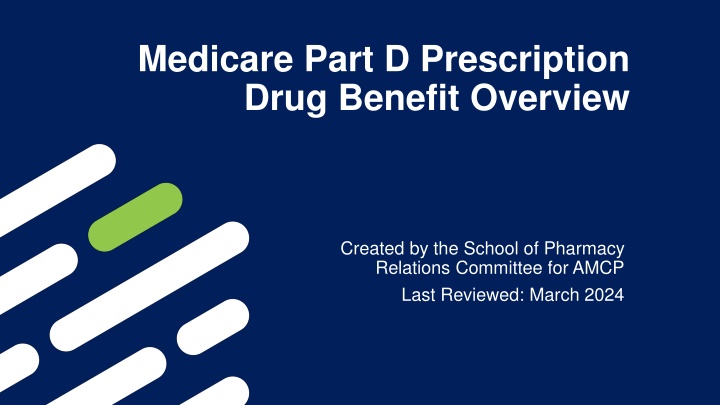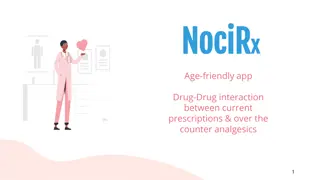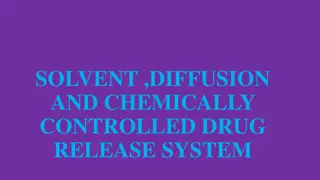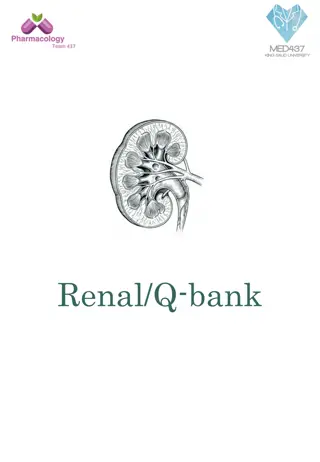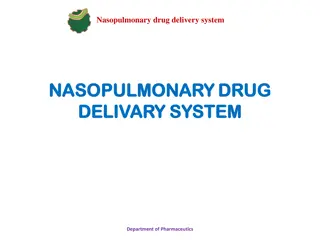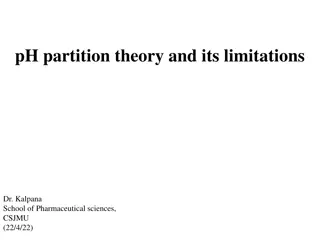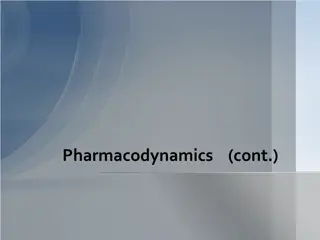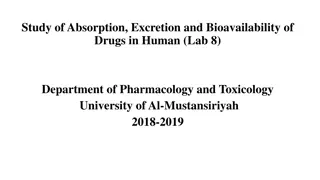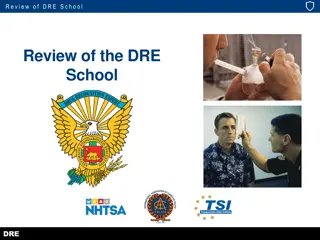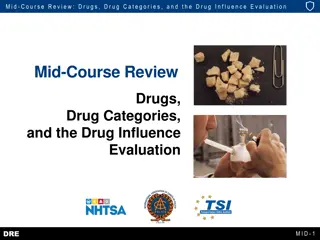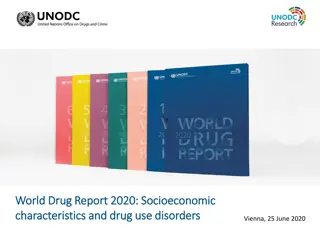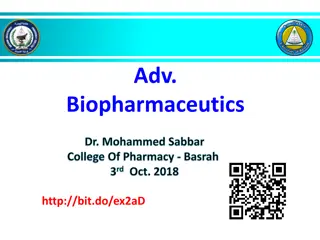Drug Benefit Overview
Medicare Part D is a crucial aspect of the federal health insurance program, providing coverage for prescription drugs. Learn about eligibility criteria, coverage details, and key drug categories under Medicare Part D, along with information on Original Medicare, Medigap policies, and the basics of Medicare. Explore how this essential benefit supports individuals aged 65 and above, those with disabilities, and individuals with end-stage renal disease.
Download Presentation

Please find below an Image/Link to download the presentation.
The content on the website is provided AS IS for your information and personal use only. It may not be sold, licensed, or shared on other websites without obtaining consent from the author.If you encounter any issues during the download, it is possible that the publisher has removed the file from their server.
You are allowed to download the files provided on this website for personal or commercial use, subject to the condition that they are used lawfully. All files are the property of their respective owners.
The content on the website is provided AS IS for your information and personal use only. It may not be sold, licensed, or shared on other websites without obtaining consent from the author.
E N D
Presentation Transcript
Medicare Part D Prescription Drug Benefit Overview Created by the School of Pharmacy Relations Committee for AMCP Last Reviewed: March 2024
Medicare The Basics Federal health insurance program administered by the Centers for Medicare & Medicaid Services (CMS) Program covers individuals: 65 years of age and older Under age 65 with qualifying disabilities Under age 65 with end-stage renal disease (ESRD)
Original Medicare Medicare Part A (Hospital Insurance): Free premium for most people Qualified individuals are automatically enrolled when eligible Covers inpatient hospital stays, skilled nursing facilities, home health care, and hospice Limited drug coverage (drugs given during covered stays)
Original Medicare (cont.) Medicare Part B (Medical Insurance): Medicare pays 80% of the Medicare-allowed amount for physician services Covers physician office visits, outpatient hospital services, and durable medical equipment (DME) Provides benefits for some drugs, including certain chemotherapy drugs, certain drug injections given during an office visit or outpatient facility, and drugs that are given at a dialysis facility
Medicare Part B Covered Drugs Medicare Part B covers a limited number of outpatient prescription drugs under certain conditions. Intravenous Immune Globulin (IVIG) provided in home Shots (vaccinations) Transplant/immunosuppressive drugs Oral cancer drugs Oral anti-nausea drugs Self-administered drugs in hospital outpatient settings (under very limited circumstances) New Alzheimer s drug (Leqembi, generic name lecanemab) Drugs used with an item of DME Some antigens Injectable osteoporosis drugs Erythropoiesis-stimulating agents Blood clotting factors Injectable and infused drugs Oral ESRD drugs Parenteral and enteral nutrition (intravenous and tube feeding)
Medigap Often referred to as Medicare Supplement Health Insurance Insurance sold to individual members Generally, one must have Medicare Parts A and B to purchase Medigap Medigap policies help pay some of the costs (i.e., deductibles, coinsurance) that the original Medicare plan doesn t cover Cannot provide outpatient prescription drug coverage
Medicare Part C (Medicare Advantage) Medicare Advantage is a Medicare-approved plan from a private company that offers an alternative to Original Medicare for your health and drug coverage. These bundled plans include Part A, Part B, and usually Part D. In most cases, need to use doctors who are in the plan s network. Plans may have lower out-of-pocket costs than Original Medicare. Plans may offer some extra benefits that Original Medicare doesn t cover like vision, hearing, and dental services.
Medicare Modernization Act of 2003 Federal legislation signed into law on December 8, 2003 Created a new prescription drug benefit (Medicare Part D) beginning in January 2006 Available to those members eligible for Medicare Part A or Part B and elderly Medicaid beneficiaries Voluntary benefit Coverage available through private insurance companies and managed care organizations (MCOs)
Medicare Part D Overview Medicare prescription drug coverage is available to everyone with Medicare. To get Medicare prescription drug coverage, people must join a plan approved by Medicare that offers Medicare drug coverage. Most people pay a monthly premium for Part D. Part D plans cover the cost of prescription drugs (including many recommended shots or vaccines). Beneficiaries can either add a Medicare drug plan to Original Medicare (Prescription Drug Plan, PDP), or by joining a Medicare Advantage Plan with drug coverage (MA-PD). Plans that offer Medicare drug coverage are run by private insurance companies that follow rules set by Medicare. Members select and enroll in plans annually (open enrollment from October to December)
Medicare Part D Late Enrollment Penalty Depends on how long a member went without Part D coverage Calculated by multiplying 1% of the national base beneficiary premium ($34.70 in 2024) x the number of full, uncovered months that a beneficiary was eligible but didn't sign up for Part D National base premium may increase each year, and penalty may concurrently increase Extra Help beneficiaries do not need to pay penalties
Medicare Part D Formulary CMS set guidelines Formularies must cover beneficiaries in both community and long-term care settings Minimum coverage criteria: 2 drugs per therapeutic category/class Majority of drugs in 6 protected classes are covered: o antidepressants, antipsychotics, anticonvulsants, antiretroviral, immunosuppressant, antineoplastics Exceptions: o multi-source brands of the identical molecular structure o extended release products when the immediate-release product is included o products that have the same active ingredient or moiety o dosage forms that do not provide a unique route of administration (e.g., tablets and capsules versus tablets and transdermals)
Medicare Part D Formulary (cont.) Per CMS, the following drug classes are excluded from coverage under Part D: Over-the-counter drugs Part A- or Part B-covered drugs Excluded drug categories: oAnorexia/weight loss/weight gain oFertility agents oAgents for cosmetic purposes or hair growth oAgents for symptomatic relief of coughs and colds oPrescription vitamins and minerals (except prenatal and fluoride preparations) oErectile dysfunction
Medicare Part D Formulary (cont.) Drug formularies are specific to each plan (i.e., coverage will vary from plan to plan) Copayment or co-insurance vary Restrictions on coverage can include: Prior authorization (PA) Quantity limits (QL) Step therapy (ST) Upcoming drug maintenance and negative formulary changes require a 60-day member notification Includes PA, QL, and ST notifications
Medicare Part D 2024* Standard Benefit Limits Members are responsible for: Monthly premium (set by the plan) Initial Coverage Period: Depends on plans benefit structure. Plan will pay some cost, member pays a copayment/coinsurance. For most plans, this period ends after the member has accumulated $5,030 in total drug costs (TDS). Once TDS is met, the member falls into the coverage gap (donut hole) where member pays 25% of plan s cost for prescription drugs. The donut hole closed for all drugs in 2020, meaning when a member is in the coverage gap will be responsible for 25% of the cost of your drugs. In the past, they were responsible for a higher percentage of the costs. Annual deductible ( $545) Health plan drug coverage (copay/coinsurance set by the plan) * Deductibles, initial, and catastrophic amounts/limits can change. Consult updated resources for current numbers: https://www.medicareinteractive.org/get-answers/medicare-prescription-drug-coverage-part-d/medicare-part-d-costs/phases-of-part-d-coverage
Medicare Part D 2024* Standard Benefit Limits (cont.) Coverage gap: member responsible for 25% of cost for prescription drugs and dispensing fees Member continues to pay out-of-pocket until their out-of-pocket costs (not TDC) reaches $8,000 (set by CMS). Deductible, cost share, and member spend in coverage gap all contribute to this threshold In this phase, the member falls into catastrophic coverage where member pays no cost-sharing for the remainder of the year * Deductibles, initial, and catastrophic amounts/limits can change. Consult updated resources for current numbers: https://www.medicareinteractive.org/get-answers/medicare-prescription-drug-coverage-part-d/medicare-part-d-costs/phases-of-part-d-coverage
Medicare Part D Inflation Reduction Act The prescription drug provisions included in the Inflation Reduction Act will: Require the federal government to negotiate prices for some drugs covered under Medicare Part B and Part D with the highest total spending, beginning in 2026 Require drug companies to pay rebates to Medicare if prices rise faster than inflation for drugs used by Medicare beneficiaries, beginning in 2023 Cap out-of-pocket spending for Medicare Part D enrollees and make other Part D benefit design changes, beginning in 2024 Limit monthly cost sharing for insulin to $35 for people with Medicare, beginning in 2023 Eliminate cost sharing for adult vaccines covered under Medicare Part D and improve access to adult vaccines in Medicaid and CHIP, beginning in 2023 Expand eligibility for full benefits under the Medicare Part D Low-Income Subsidy Program, beginning in 2024 Further delay implementation of the Trump Administration s drug rebate rule, beginning in 2027 * Deductibles, initial, and catastrophic amounts/limits can change. Consult updated resources for current numbers: https://www.medicareinteractive.org/get-answers/medicare-prescription-drug-coverage-part-d/medicare-part-d-costs/phases-of-part-d-coverage
Medicare Part D Inflation Reduction Act 2024: Law eliminated the 5% coinsurance requirement above the catastrophic coverage threshold, effectively capping OOP costs at $3,250 2025: adds a hard cap on OOP spending of $2,000 (indexed in future years to rate of increase in per capita Part D costs) * Deductibles, initial, and catastrophic amounts/limits can change. Consult updated resources for current numbers: https://www.medicareinteractive.org/get-answers/medicare-prescription-drug-coverage-part-d/medicare-part-d-costs/phases-of-part-d-coverage
Medicare Part D Low Income Dual eligible: Medicaid beneficiaries eligible for Medicare Medicare Savings Program (MSP) categories include: oQualified Medicare Beneficiary (QMB) Program oSpecified Low-Income Medicare Beneficiary (SLMB) oQualifying Individual (QI) Program oQualified Disabled Working Individual (QDWI) Program Extra Help: Federal program that helps pay for some to most of the OOP costs of Part D drugs. Also known as Part D Low- Income Subsidy (LIS)
Medicare Part D Extra Help Example Mr. S has Extra Help and a monthly income above $1,235, so his Extra Help copays are $4.50 for generics and $11.20 for brand-name drugs. However, his plan copay for his generics is $2.00. Mr. S will therefore pay the plan copay of $2.00 because it is cheaper than the Extra Help copay of $4.50. If Mr. S had Extra Help and a monthly income below $1,235, his copays would be $1.55 for generics and $4.60 for brand- name drugs, making his generic Extra Help copay less costly than the plan copay of $2.00. This means that Mr. S would pay the Extra Help copay throughout the year.
Medicare Part D Explanation of Benefits (EOB) Part D members receive an EOB for each month they fill a prescription, which allows members to monitor their benefit status Includes a summary of the services and items you received, how much was paid, and how much is owed An EOB is not a bill, and not the same as a Medicare Summary Notice
Medicare Part D Additional Resources Centers for Medicaid & Medicare Services ww.cms.gov Official US government site for Medicare (can compare health and drug plans) www.medicare.gov
Mission & Vision To improve patient health by ensuring access to high-quality, cost-effective medications and other therapies.
